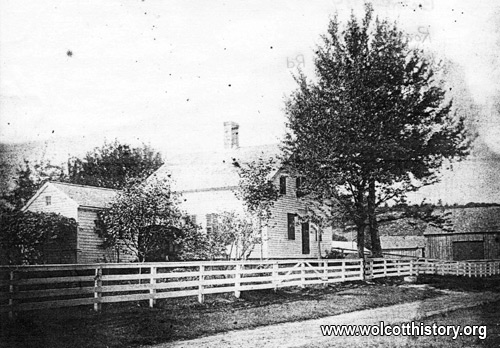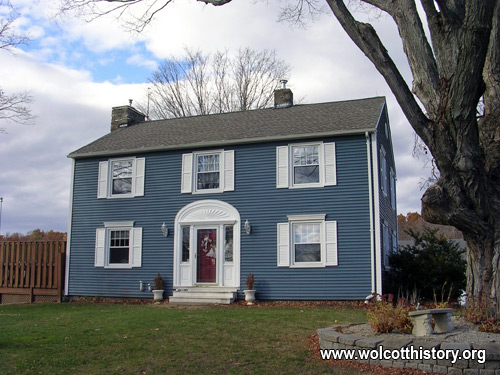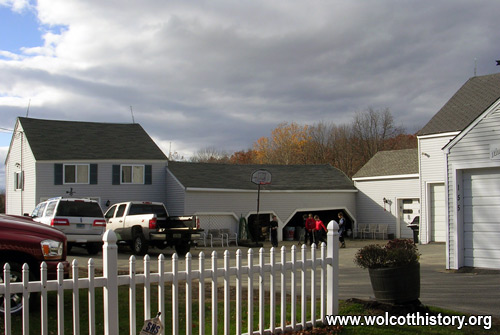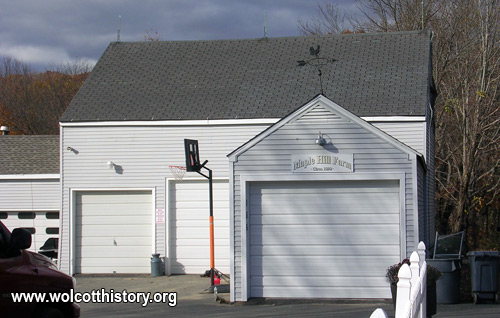|
|
||||||||||||
 |
 |
|
Wolcott Historical Society News - November 2010 By Florence Goodman In this edition I will discuss one of two farms in the Wolcott District that I missed in a previous discussion of this section of town. These two farms were located on land close to the center of town. They are the Charles C. Rogers Farm and the Douglas Farm.
The Charles C. Rogers House/Maple Hill Farm was located one half mile south of Wolcott Center at 155 Bound Line Road in an area called "Hogs-Fields Hill." The farm originally belonged to Major Luther Hotchkiss who married Anne Hall in 1800. After their marriage, they continued to live on the farm as the land was said to be the most "tillable" land in town.
Luther and Ann had five children and one of their son's, Stiles Luther Hotchkiss, born in 1817, married Ann Holt in 1836 and they had three children. Their daughter, Mary Rafina married Henry B. Carter in 1860 and lived in a house on Coe Road. Around 1885, Henry and Mary sold the Coe Road house and took over Mary's family home on Bound Line Road. Henry added to the structures on the property by building a large horse barn and shed, which were attached to an existing building and hay barn. All four of these structures are still standing today.
Mary Rufina Hotchkiss Carter was a correspondent for the Waterbury American newspaper for many years and in 1913 she wrote a story about life on early farms since she spent most of her years living on farms in Wolcott. She was born in 1840 and died in 1931, so she saw many changes take place on the farm. In 1863 the first mowing machine was used on their Bound Line Road farm. They had a one-horse mowing machine, but there was a heavier cattle-drawn machine available. This was also about the time that four-wheel wagons began to be used for carrying loads; prior to this two-wheel vehicles did all the carting. Men raked hay by hand until rakes were added to the machines.
Farming changed over time as farm implements improved; cultivators replaced the hoe, the mower replaced the hand scythe, and the horse rake replaced the hand rake. Most of the food that families ate was raised on the farm. Barrels of pork and beef as well as all garden vegetables were stored in the cellars over the winter. Corn was grown to feed livestock and for flour to make Indian pudding and Johnny cakes. Rye was grown to be ground up to make flour. Mary Rufina Carter knew that farm life was not for the weak of heart or mind and stated that, "Éearly farmers truly earned their living by the sweat of their brow."
Before moving to Wolcott, Charles C. Rogers owned and operated a milk distribution business in Waterbury. He purchased milk from farmers in Watertown and Sandy Hook and hauled the milk in forty-quart cans on flatbed, three-horse wagons from Watertown to Waterbury and by train from Sandy Hook to Waterbury. He had eighteen to twenty horses that consumed large amounts of hay that he had to purchase and in turn, they produced large amounts of manure, which he had to pay someone to dispose of.
In the late 1890s, Charles told his soon to be wife, Josephine, that he should buy a farm where he could grow his own hay and dispose of the horse manure; so in the early 1900s, Charles attended an auction and bought the Henry Carter farm. The next day there was a heavy snow and when Charles brought Josephine out to see the farm he had a hard time finding it because the land looked so different after the snowfall. Charles used the property to grow hay until 1914 when he raised the roof of the house and added a second story, but it wasn't until 1916 that he moved his family into the house.
Over time, Charles Rogers purchased additional land on the east and west sides of Bound Line Road up to Wolcott Center and down to Woodtick Road; the farm eventually consisted of about 103 acres.
In February of 1934 a fire broke out in the house and much of the original structure burned and had to be torn down. By July of the same year a new house was built on the property. The new house was built over the original cellar, but was extended fourteen feet to the west and instead of facing Bound Line Road; the new house was built to face south toward the lawn and Coe Road.
Charles and Josephine's son, Arthur and his wife, Helen acquired the farm in 1980; it remained in their possession until 1996 when Arthur suddenly died, his wife had died prior to this date. Arthur Roger's grandnephew, Richard Rogers, his wife Darleen and their family moved into the house in 1997 and still live on the farm at this writing.
(Information for this article was taken from Notes from Arthur Rogers, April 1993, a 1963 article written by Eva M. Tyrrell called, Earlier Writer Recaptures Old Farm Life in Wolcott, conversations with Bud Rogers and Richard Rogers, The History of Wolcott, Connecticut from 1731 to 1874 by Samuel Orcutt, and 1986 Historic Resources Inventory by Paul Loether.)
Rogers Farm
Rogers House
Rogers Maple Hill Farm
Maple Hill Farm
To view past installments of the Wolcott Historical Society News, click here.
|
|
|
[Home]
[News]
[Purpose]
[Calendar]
[Museum]
[Membership]
[History]
[Contacts]
[Links]
All material at Wolcott Historical Society Web sites Copyright © 2000-2010 Wolcott Historical Society |



